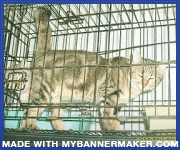Hello! Welcome to Selecting MatesThis section of the site is all about selecting the pair of rabbits you are mating. This is one of the most important issues in rabbit breeding, and it is also more complicated than you might think. Don't just whip out a buck and a doe and smack them together, there's allot more to it. Checking the Health of Your RabbitsBefore mating, check is the gender of both rabbits. If you stick a doe in with a doe, or a buck in with a buck, the results won't be very productive. Also, if you cannot tell what gender the rabbit is because you can't really see it, the rabbit is too young to breed. I will show you the external sex organs of both male and female.
Also before mating, check the overall health of both rabbits, because if they have anything wrong with them, such as contagious diseases, the rabbit you are mating it to could catch the disease from its mate. Also, you want to have the healthiest doe possible, because it's hard work raising a litter, and she needs to be in top condition, and also because the health of the babies rests upon the mother quite often. Common rabbit diseases that you would easily noticed and you should check for before mating are:
Also, you must examine both the mate's genital areas before mating. Some states of the outer sex organs will tell you how easily this pair will mate and successfully produce a litter. Female-when you look at the female, you should primarily look at the color of the external sex organ. If it is light pink or purple, you can still mate her, but she probably won't take as easily as she will if her sex organ is bright pink or red. Females should be 5 months old before mating, preferably 6 months. Male-when you look at the male, both testicles should be fully descended and full, not shriveled up, as they sometimes get in very cold or hot weather or in older years. The penis should be pink and healthy looking. Males should be at least 5 months old before mating, preferably 6 months. Genetic DisordersSome things that can go wrong in a rabbit are caused by genetics. A very good example is a disorder called malocclusion, the misalignment of the teeth. This is easily noticed if you check your rabbits frequently. It can cause the rabbit difficulty in eating, pain, and even death. If one of the parents has this disorder, the genes will be passed on to the young and up to 50-75% of the litter could be born with dominant genes for malocclusion, and develop it during youth. Any other babies in that litter will carry the recessive genes for it, and are viable to pass them on to their own young. Another genetic problem is terrible motherhood, which often results in the death of some, most, or all of the litter born to a mother with this trait. It isn't a disease, but it is very bad to carry in your stock. What you should do is before buying the rabbit, ask if it has had any litters and were they successful. If the rabbit has not had any litters, and she is of good show type, buy her anyway and find out for yourself. If she is a terrible mother the first time and kills her babies for no reason, do not mate her again, because she will give this trait to any live does she produces. If she is a good mother, but not the greatest show doe, keep her anyway. You ALWAYS need a reliable mother on hand. Even if a good mother sometimes injures her young because she was disturbed or on accident (like stepping on them), or doesn't feed them, well, mistakes happen and it doesn't mean she'll keep doing that every time. Complimentary CharacteristicsIf you are breeding show rabbits, this is a very important issue if you want to have good rabbits. The reason is this: almost all of a rabbit's aesthetic and physical characteristics are genetic. By selectively selecting two rabbits who's features put together would make a better rabbit, you have made a big step in making your stock better. A very important thing to do before trying to select the best rabbits is to research your breed in the ARBA Standard of Perfection. Every rabbit breeder should have this, as it is the most important research tool for finding out how your breed is supposed to look. I didn't know about my breed before I purchased any rabbits, so I ended up getting some bad deals. I learned the hard way, but you don't have to. Also: talk to other breeders of the breed you are interested in, and ask them everything you need to know. Go to rabbit shows and ask around for the most renowned names of breeders for your breed. Ask them about things, and they should give you some good answers. Beware though: not everyone will say the same thing. One of the most important issues in characteristics is color (that is, in most breeds). When talking about rabbits, "color" refers to everything except white. White is referred to as a variety only, while colors are referred to as both colors and varieties. Some breeds, like the Californian, the Florida White, and the two Hotot breeds' quality don't depend on coloring at all, but most breeds do. I raise Polish and color is very important for them. Here's an example of color improvement by breeding: Say I have a blue rabbit who's color s too light for the Standard. I would breed her to a nice, dark black rabbit. This would make any blue offspring in the litter have a darker color. Not dark enough yet? I would keep breeding blacks to my blues, and sooner or later, the change would be very evident. You should also watch out for complimentary characteristics in body type issues. Since my breed, Polish, has a rounded head, that's what I would want in my stock. Say I had a rabbit who had excellent characteristics everywhere except her head. Her head is too pointy for a Polish. I would breed her to a buck with a very round head, and the heads of the offspring would be rounder than their mother's was. Again, if the change isn't evident enough, keep breeding together the roundest heads you have. Purchase new rabbits, even! These are the things you must do to eventually have good rabbits. If you want to find out about color genetics or other genetics, you might want to visit this site: DebMark Rabbit Raising NOTE: DO NOT expect immediate results! It took me over one and a half years to get the only Grand Champion I have, and it took me a year and half to REALLY know what a good Polish was. If you think you know everything, look again. On to Mating! |
POKOK MAJAPAHIT @ Qudrifarm
5 years ago















The Hutch Company is the UK largest timber pet home manufacturer.We manufactuer and dropship Rabbit Hutches, www.homeandroost.co.uk
ReplyDelete